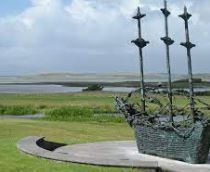Articles
Narratives of migration in Ireland
6 February, 2023

By Emma Barker from Eurospeak Limited
Reflecting on the rich tapestry of Ireland’s history, our nation’s story is intricately woven with the narratives of migration and diaspora, which have shaped not only our homeland but also the diverse cultures and societies where Irish communities have flourished. Amidst the captivating beauty of Ireland’s landscapes and the warmth of its welcoming culture, a tapestry of diversity is being woven. Migrants from diverse corners of the world are not just settling here; they are becoming part of Ireland’s vibrant fabric, bringing their unique stories, talents, and experiences to enrich our society.
But who are asylum seekers? They are individuals seeking refuge and protection outside their homeland while awaiting a decision on their status. Once granted refugee status, they are no longer asylum seekers. In Ireland, the asylum process is a legal system that determines who qualifies as a refugee, ensuring their right to remain under Ireland’s protection. Those who don’t qualify as refugees may receive subsidiary protection, ensuring they cannot be deported.
The terms ‘asylum seeker’ and ‘refugee’ can be confusing. An asylum seeker is someone claiming refugee status whose case hasn’t been evaluated yet, while a refugee is someone who fled their home due to fear of persecution based on race, religion, nationality, social group, or politicalc opinion.
At the heart of this integration journey are initiatives supporting migrants. From language classes aiding communication to programs fostering workplace diversity, Ireland opens its arms to migrants, recognising their valuable contributions.
For those seeking a safe haven in Ireland, life in direct provision accommodation comes with challenges. Yet, there’s hope as changes are being made, granting asylum seekers the right to work after six months. They also receive medical support and essential financial aid.
Young asylum seekers face a unique path. Children often reside with their parents in accommodation centres. Separated children seeking asylum receive care from TUSLA and are supported in education until completing the Leaving Certificate. Upon turning 18, they transition to adult centres, facing what’s known as ‘aging out.’
The success story doesn’t end there. Once granted refugee status, individuals have the right to reside in Ireland, access education, and apply for family reunification. Subsidiary protection grants similar rights and the possibility of renewal.
Migrant workers contribute significantly to Ireland’s economy. Work permits allow migrants to fill job gaps while contributing their skills. However, there are misconceptions about immigration rules, leading to confusion, particularly for children in education.
Yet, amidst these stories lies an issue – undocumented migrants. It’s important to avoid terms like ‘illegal’ as everyone has the right to seek asylum. The term ‘undocumented’ accurately describes those in irregular migration status, highlighting the need for a route to regularisation.
At the core of Ireland’s inclusive embrace lies a commitment to support and empower those seeking refuge within our shores. Beyond policies and legal definitions, these individuals bring resilience, diverse perspectives, and unwavering hope for a better tomorrow. As we continue to evolve, it’s crucial to foster an environment where integration isn’t merely a process but a collective journey of understanding, empathy, and shared prosperity. Together, we stand poised to celebrate the rich tapestry of cultures and stories, united by the common thread of humanity. Ireland’s legacy of migration isn’t solely about departures and arrivals but a testament to resilience, unity, and the ongoing endeavour to create a more inclusive and welcoming society for all who call it home.
